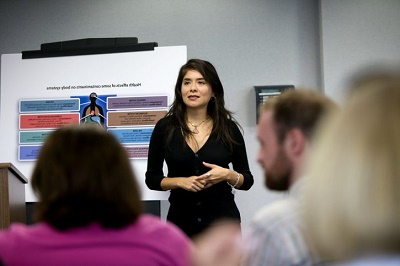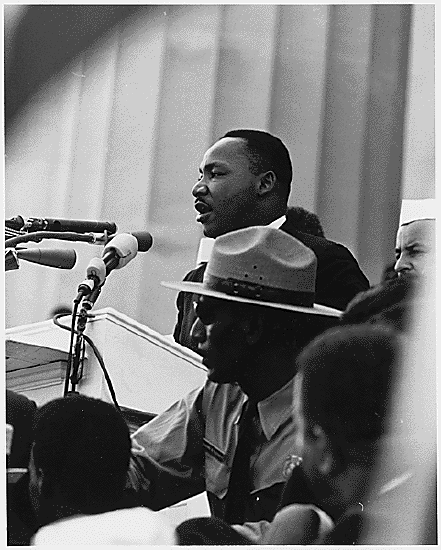Learning Objectives
After completing this section, students should be able to:
- describe how public speaking differs from Interpersonal Communication and Small Group Communication.
- explain the societal value of public speaking.
- explain the personal benefits to learning public speaking.
- apply the traits of a good speech in creating and presenting a speech.
- describe the general speech purposes.
The oldest form of public communication and the precursor to mass media is the simple act of one person rising and expressing their thoughts to the group. Public discourse is the foundation of society; it is how groups of people address and resolve differences collectively and peacefully. With the rise of democracy in Ancient Greece, the value of public speaking gained prominence. A citizen's ability to speak their mind in public was highly valued and a sign of civic engagement.
Although we have so many avenues to express ourselves, from in person to online, the ability to craft and share a thoughtful, intelligent message is still an important skill. For a person's career, civic involvement, and political engagement, becoming proficient in public speaking is a highly valuable.
The Nature of Public Speaking
|
Public speaking has three striking characteristics that set it off from interpersonal communication and small group communication.

Figure \(\PageIndex{1}\): Image 1
First, public speaking is the act of one person speaking to many. Instead of focusing on an interactive nature, public speaking focuses on one person, the speaker, developing and presenting a message to a group of individuals.
Second, public speaking is a more formal presentation, meaning it is bound by specific strategies and techniques. Good public speaking requires more planning, development, and self-reflexiveness, than the other two contexts.
Third, in the other two contexts, we see all members communicating from a position of shared, equal responsibility. In public speaking, the speaker bears more responsibility as the message is one-directional, and the feedback the speaker receives from the audience is subtler, such as facial expressions, body posture, and fidgeting. Public speaking is still an interaction, just like interpersonal and small group, but the responsibility for success is less balanced with more responsibility being placed on the speaker.
The Value of Public Speaking
|
Given the fear that most people have of public speaking, it is reasonable to ask why we engage in such an intimidating process. The fear of public speaking is common, often ranked as one of the top fears we have. A Gallup poll from 2001 found that 40% of respondents listed public speaking as their greatest fear, second only to a fear of snakes. Given a choice, people preferred dying over giving a speech. Even with this high degree of anxiety, public speaking retains a valuable place in our culture for several reasons.
Societal Functions
Public speaking has a long, illustrious history in the United States. The very formation of the U.S. political system and society is firmly rooted in wise people speaking their minds in public settings, engaging in spirited debate and discussion, and working collaboratively to find the best path for the country. Our country is founded on the premise that individuals, working together, can govern themselves. Public speaking is the tool by which this process occurs.
Public speaking allows for the relatively quick dissemination of information to a group of individuals.
If a person has much to share with a group, presenting the information via public speaking can be a fast process. A classroom lecture is a typical example. However, a question that begs to be asked is how effective such dissemination is in achieving this goal. In lecture, approximately 5-15% of the material is retained by the student; hence, the speaker (the teacher in this case) must realize this limitation and be willing to use public speaking as a starting point, using other follow up methods to enhance retention of the information.

Figure \(\PageIndex{2}\): Image 2
Public speaking allows individuals or groups to attempt to bring about social or political change.
We have a long history in this country of using our freedom of speech to change what we don't like. The women's movement and the civil rights movement of the mid-20th century, and the TEA party movement of the early 21st century are examples of such a process occurring. Individuals see something happening around them they do not like, and they use public speaking to make others aware of the problem and advocate a way to change the situation.

Figure \(\PageIndex{3}\): Image 3
Public speaking allows communities to express common goals, concerns, and values.
We see speeches of commemoration at Memorial Day, Veteran's Day, and the Fourth of July. The speeches remind us of who we are as a nation, and they express common values. Attending a Sunday sermon is the same. Churches, mosques, and synagogues exist for a group of individuals to share common values and worldviews. The sermon is the central feature which pulls the community members together, the faith leader giving voice to that common world view.
Public speaking allows members of a democratic society, such as the United States, to actively debate issues of concern.
We tend to take for granted our First Amendment right to openly and clearly disagree with our governmental structures on issues of concern. We have the legal right, and obligation some would say, to speak out in opposition to those things with which we disagree. Except for advocating violence, we can speak out against our mayors, governors, and presidents, and no one has the right to squelch our voice. When we speak out in a public forum, we are participating in the process of self-governance by exercising our freedom of speech.

Figure \(\PageIndex{4}\): Image 4
Personal Benefits
In addition, to the role of public speaking in our American society, becoming competent as a public speaker benefits us personally.
Managing Anxiety
Given the anxiety about public speaking, and our need to confront and manage that anxiety, we build self-confidence. Accepting and working with our speech anxiety gives us experience in facing situations in which we are being judged and evaluated. Learning how to confront fear in public speaking gives us tools to use to confront fears in other situations as well.
Managing Our Self-Presentation
We learn to monitor and manage our self-presentation. Since the vast majority of communication occurs nonverbally, a competent public speaker knows how to manage their entire physical package to present themselves most effectively, confidently, and powerfully. Just as with confronting our anxiety, being able to self-reflexively manage our self-presentation carries over into all aspects of our professional and personal lives. Although talent and ability is a significant part of career success, communication ability sets people off as especially competent and professional. The ability to engage in effective self-presentation can be a deciding factor in getting a job, being successful in the job, and advancing in our careers.

Figure \(\PageIndex{5}\): Image 5
Packaging Information for Others
We learn how to package information to benefit others. Good speakers are highly receiver-oriented. We are very concerned about giving thoughtful, well organized, easily followed, and engaging presentations. The ability to create messages fitting these standards will serve any of us well in a variety of professional and personal settings. Many people have good ideas, but not everyone can communicate them well to others. In public speaking, we learn how to package our message to best fit the audience we have at the moment.
Unfortunately, for most people our exposure to public speaking has left us with a distorted view of what makes a "good" speech. Virtually anytime we ask a class, "What is the first thing that comes to mind when you think of listening to a speech," the answer is "boring." This does not have to be the case; it is the job of the speaker to make choices that directly influence how interesting or boring a speech is going to be.
As speakers, we have the obligation and ability to choose how effectively and dynamically we will present ourselves and the information to the audience. We can give interesting, dynamic, energetic, and engaging speeches. Each of us has experienced teachers who were boring and monotone, but we have also experienced teachers who were dynamic and energetic. The latter group chose to make the speeches (lectures) more interesting. To make a speech more interesting and effective, we need to understand what makes a good speech:
- A good speech is well structured and signposted to enhance clarity and memory value. A good speech is organized and easily followed with clear, obvious transitions. Our job as speakers is to present a message clearly and thoughtfully, and clear structure facilitates that.
- A good speech sounds like "organized conversation." The phrase is meant to invoke the image of a speaker presenting naturally and comfortably; just talking to the audience, in an organized, easily followed manner.
- A good speech has a purpose, clear to the audience and to which the speaker adheres. Good speakers make their purpose clear and they fulfill that. They do not wander, drift about, shift purposes, or mislead the audience. They do not start off informing the audience, and then suddenly shift to persuasion.
- A good speaker is active, not passive. Too many speakers, especially novice speakers, tend to use the "open my mouth, let the words fall out" approach to speaking. This thoughtless approach to public speaking is not very effective. Good speakers make choices, determining throughout their speech the best strategy for the given audience. Through the preparation and practice process, we make decisions based on what we think will increase the likelihood of success. Such strategic thinking requires careful consideration of the topic, the audience, the speaker, and knowledge of the interaction of these three components.
- A good speaker works to create immediacy with the audience. Immediacy is a sense of connection; that the speaker, the topic, and the audience are all working together. Good speakers see a speech as a time to share a message with an audience, building a bridge between the speaker and the audience. Too often novice speakers see the audience as a barrier to success, a collective of judgmental individuals out to embarrass the speaker. However, that is simply not true of most audiences. Audiences want the speech to be good because it validates the time spent listening, it is more enjoyable, and it simply makes the time go faster. If a speaker taps into the audience's interests and personality, they can be quite effective in engaging the audience. Such engagement does not happen automatically; it is the result of thoughtful planning and preparation.
Video \(\PageIndex{1}\): Video 1 youtu.be/i0a61wFaF8A
The public speaking situation is quite different from interpersonal communication and small group communication. The degree of advanced planning, of conscious decision making, and of communicator responsibility is much higher when giving a speech. We have been taught when a person goes to the front of the room to speak, the speaker is now "in charge" of the event. We must meet that expectation, take charge of the event, and fulfill our responsibilities for success. Speeches are only as good as the audience thinks they are; the speaker must rise to the challenge of presenting a good speech.
When developing a speech, we need to know why we are speaking. Even before considering the topic, we need to know if our purpose is to inform, to persuade, to entertain, or if it is a special occasion.
Speeches to Inform
Speeches to inform are those in which we are aiming to enlighten or to further educate the audience, but in an objective, non-directive manner. We provide the information about the topic to the audience, but we are not directing the audience to believe, feel, or act in a specific manner.
There are three types of informative speeches.
- Report speech. A speech to report is one in which we take a single body of information, analyze it for the important points, then present a summary of those important points. This is common in a business setting. For example, if ACME Industries is considering making and selling a new product, various divisions will do research to determine the likelihood of the product being a success and profitable. Once this feasibility research is done and compiled into a single report, a single person or a group will then present the key findings to the management so they can decide on the course of action to take.
- Demonstration speech. These are classic "how to" speeches, usually arranged in a step-by-step pattern. For example, Mary may give a speech on how to be creative with Ramen noodles. She will progress, chronologically, through a series of steps the audience can then follow on their own.
- Explanation speech. Speeches of explanation are presentations drawing from multiple sources, designed to generally enlighten the audience about a given topic. They are not designed to show how to do something, but are for generally increasing the audience's knowledge about the topic. Instead of speaking on how to make Ramen noodles, Mary may explain how good nutrition aids classroom performance in college.
Speeches to Persuade
Speeches to persuade are those in which we are aiming to influence the audience in some fashion. They are subjective and highly directive. The speaker has a bias toward a specific belief, attitude, or action, and the speaker works to direct the audience in what to believe, what opinion to have, or what action to undertake.
In persuasion, the issue of ethics becomes paramount. Some students erroneously believe that speakers always have to give both sides of the issue to be ethical, but that is not true. When Lisa shops for a car, she knows the salesperson is out to persuade her to buy; thus, she expects messages designed to urge her to that action. As long as the salesperson gives accurate, verifiable, and truthful information, there is no ethical violation.
It is our job to provide the audience with the most accurate information we can find, and to present that information honestly, not distorting it. We must cite our sources to give due credit, and the topic should be one that can be justified as beneficial to the audience, not just to the speaker.
There are three types of persuasive speeches.
- Persuasive speeches to influence beliefs. A belief is what we hold to be true or false. For example, the knowledge that the Earth rotates around the sun is a belief; we believe it to be factual information. The idea that smoking can cause cancer is a belief. If we try to persuade the audience consuming too much fat can cause colon cancer, we are trying to get the audience to believe what is true or false about the impact of fat in our diets.
- Persuasive speeches to influence attitudes. We attempt to influence how an audience judges an event or idea; the speaker is trying to influence the audience's opinion of something. For these speeches, the speaker is attempting to make the audience think of the topic on a scale of good to bad, or desirable to not desirable. To argue the Governor of Minnesota is doing a good job (or a bad job) is an attempt to influence an attitude or opinion. With statements like these it is not a matter of true or false, black or white. It is a matter of placing the Governor on a range of opinion from highly positive to highly negative.
- Persuasive speeches of actuation (or action). We try to get the audience to engage in a specific behavior. Advertising is a prime example. We are asked to have a positive opinion of a product, and then to act by purchasing.
The three types of persuasive speeches build on each other. If Yousef is going to give a speech of actuation calling for the audience to donate blood during Ridgewater College's annual blood drive, he will need to show the audience there is a need for blood (a belief), that donating blood is a good thing to do (an attitude), and how to participate in the blood drive (an action).
Speeches to Entertain
Although not commonly done in an introductory Communication Studies class, there is a third general speech purpose: a speech to entertain. We would hope all speeches are entertaining in some fashion, whether through humor, interest, or seriousness, so the audience found the speech engaging and intriguing. A true speech to entertain, however, is one in which the primary focus is to generate laughter. In other words, they are speeches intended to be funny.
These are still speeches in that they are organized, have a clear structure, and flow well, but they have as their overall goal the creation of laughter in the audience. The speaker usually has an underlying serious informative or persuasive point, but it is explored and developed through the use of humor. Commencement addresses, especially by those delivered by comedians or comic actors, like Tom Hanks, are typically structured this way. The speaker has a serious point to make but develops it in a humorous manner. These are common at events such as celebratory dinners or awards banquets.
Special Occasion Speeches



Figure \(\PageIndex{6}\): Image 6 Figure \(\PageIndex{7}\): Image 7 Figure \(\PageIndex{8}\): Image 8
A special occasion speech is just what the name states: speeches given at special events. This is actually a very common type of speaking. Special occasion speeches are designed to fit the specific event at which they are being given. While each one has its own unique guidelines, the key point is to develop the speech consistent with that occasion.
Some common special occasion speeches include:
Eulogy: a speech given at a funeral or memorial service to honor the deceased.
Introduction: a speech given to introduce a speaker to an audience.
Toast: a speech given honoring a person or group, such as a wedding toast.
Giving an Award: a speech given to bestow an honor on a person.
Accepting an Award: a speech given to communicate appreciation for an award.
Commencement: a speech given at a graduation, typically addressing the past (the work done to acheive the goal) and the future (challenging the graduates to learn more, help others, get involved in social issues, or otherwise continue personal growth).
Generally special occasion speeches are fairly short and focused on the event at hand. Humor is commonly used, even with many eulogies, but only when appropriate for the event and audience.
The terms and concepts students should be familiar with from this section include:
The Nature of Public Speaking
The Value of Public Speaking
A Good Speech
General Speech Purposes
Special Occasion Speeches
Gallup. ( 2001, March 19). Snakes Top List of Americans' Fears. Retrieved from http://www.gallup.com/poll/1891/snak...ans-fears.aspx










